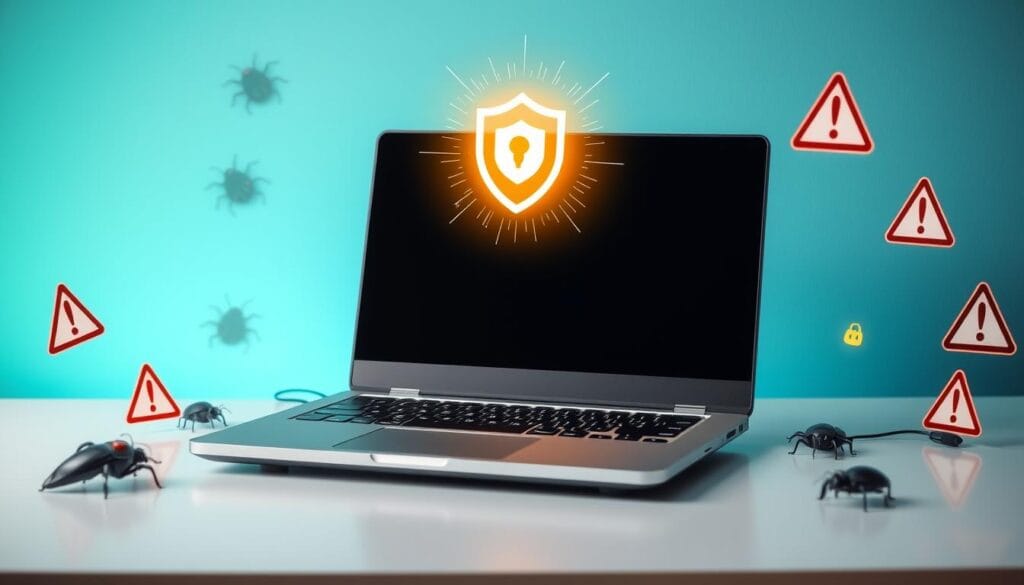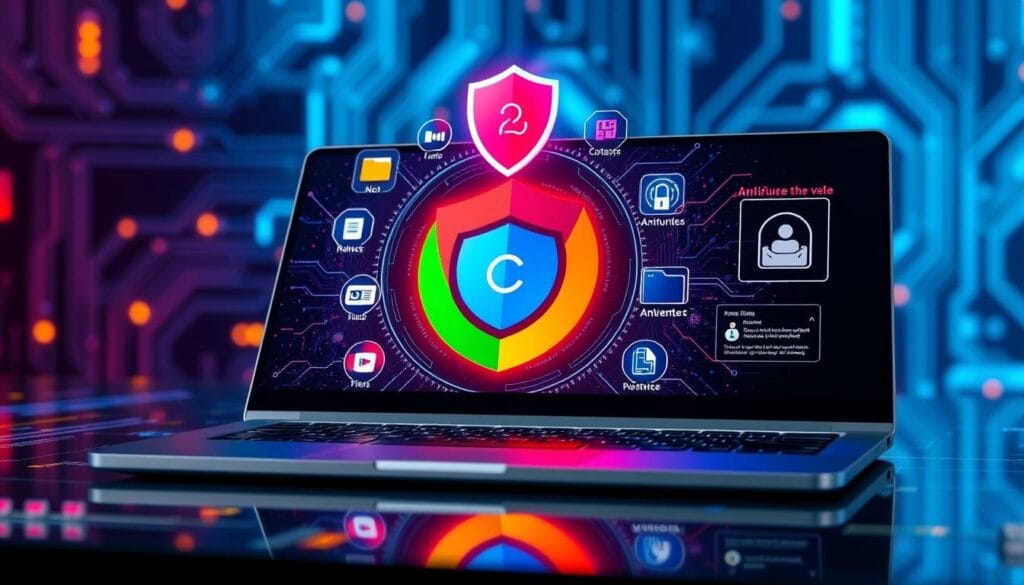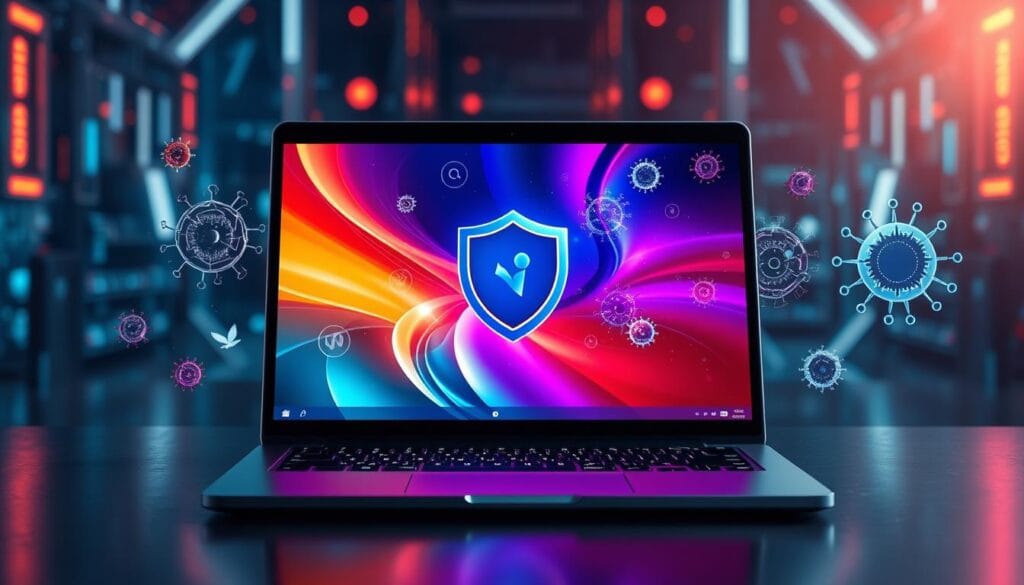Table of Contents
I remember the frustration when my Chromebook got malware. Finding a good guide to clean it was hard. But, I found a solution and now I want to help you. If you’re having trouble with chromebook virus removal, you’re in the right spot.
It’s key to know how to clean your Chromebook from malware and viruses. This protects your data and keeps your device running well. In this article, we’ll show you how to remove malware and viruses from your Chromebook.

Whether you’re a student, professional, or just a Chromebook user, knowing how to clean your device is crucial. It keeps your device safe and running smoothly.
Key Takeaways
- Understanding the importance of Chromebook security and how to clean your chromebook from malware and viruses
- Identifying signs of malware infection and taking prompt action for chromebook virus removal
- Using built-in security features and recommended tools for chromebook virus removal
- Implementing best security practices to prevent future malware infections
- Learning how to clean your chromebook from malware and viruses to protect your personal data
- Taking regular backups to ensure data safety and integrity
Understanding Chromebook Security: Why It Matters
As a Chromebook user, knowing how to protect your device is key. Chromebooks have strong security features like sandboxing and verified boot. But, they can still face threats, so it’s important to stay informed and take action.
Chromebooks are different from regular computers. They run on Chrome OS, which focuses on security. With automatic updates and sandboxing, Chrome OS adds extra protection against malware and viruses.
Common Security Threats to Chromebooks
- Phishing attacks
- Malicious extensions
- Unsecured Wi-Fi networks
To keep your Chromebook safe, follow security tips and know about common threats. Keeping your Chromebook updated with the latest security patches is also crucial. This ensures you have the best protection against threats.
The Built-in Security Features of Chrome OS
Chrome OS comes with features like verified boot and sandboxing. Verified boot checks if your Chromebook is running the right OS version. Sandbox isolates apps, keeping them from accessing sensitive data. Using these features helps protect your Chromebook from malware and viruses.
Signs Your Chromebook May Be Infected
As a Chromebook user, knowing the signs of malware or virus infection is key. Malware removal chromebook is urgent to avoid damage. Look out for slow performance, lots of pop-ups, and apps you don’t know.
To clean chromebook virus, spotting symptoms is the first step. Here are important signs to watch for:
- Slow performance: If your Chromebook is slow to load apps or web pages, it might be infected.
- Frequent pop-ups: Pop-ups can be annoying. If they keep showing up, it could mean your device has adware or malware.
- Unfamiliar apps: If you see apps on your Chromebook that you don’t remember installing, it might be malware.
Being alert and acting quickly can keep your Chromebook safe. Regular updates and good security tools help prevent infections. This makes clean chromebook virus easier.
How to Clean Your Chromebook from Malware and Viruses
To keep your Chromebook safe from malware and viruses, using chromebook antivirus software is key. This software helps get rid of viruses and stops new ones from coming in. Cleaning your Chromebook involves a few steps, like doing a security check and using Chrome’s cleanup tool.
First, do a security check to find any threats. This means scanning your device for malware and viruses. After finding threats, use Chrome’s cleanup tool to get rid of them. Also, remove any suspicious extensions, as they can carry malware and viruses.
Steps to Clean Your Chromebook
- Perform a security check to identify potential threats
- Run Chrome’s built-in cleanup tool to remove malware and viruses
- Remove suspicious extensions to prevent future infections
- Reset Chrome settings to their default values
By following these steps and using chromebook antivirus software, you can keep your Chromebook virus-free. Always be careful when browsing the internet. Avoid downloading files or extensions that seem suspicious.

Essential Steps for Powerwashing Your Device
When it comes to malware protection for chromebook, powerwashing is a drastic step. It erases all local data. So, back up your files first. Use Google Drive to keep your important documents safe.
To powerwash your Chromebook, restart it and press the right keys to enter recovery mode. Then, follow the on-screen steps. After powerwashing, set up your Chromebook again and reinstall apps. This is a chance to check your app permissions and only install trusted apps.
Here are some key steps to keep in mind when powerwashing your Chromebook:
- Back up your files using Google Drive or an external hard drive
- Restart your device and enter recovery mode
- Follow the on-screen instructions to complete the powerwash
- Set up your Chromebook again and reinstall necessary apps
Remember, powerwashing is a last resort. Use it only if your device is severely infected with malware or viruses. By following these steps, you can keep your Chromebook safe and secure. For more on how to clean your chromebook from malware and viruses, check the official Google support website.
Protecting your Chromebook is key for a safe browsing experience. Whether for work or play, prioritize malware protection for chromebook. Take steps to prevent infections.
Best Security Practices for Chromebook Protection
To keep your Chromebook safe from malware and viruses, follow some key steps. Manage app permissions, update Chrome OS often, and use safe browsing habits. Being careful with app downloads and sticking to trusted sources can greatly lower infection risks.
Keeping your Chrome OS updated is a top chromebook security tip. This ensures you have the newest security updates and features. Also, using safe browsing practices, like avoiding dodgy links and sites, helps prevent malware and viruses.
Managing App Permissions
When you download apps, check the permissions they ask for. Be cautious of apps that want too many permissions, as they might be harmful. To protect chromebook from malware, only get apps from trusted places like the Google Play Store.
Updating Chrome OS Regularly
Regular updates are key to keeping your Chromebook safe. Enable automatic updates to get the latest security patches and features right away.
Safe Browsing Habits
Safe browsing is crucial to avoid malware and viruses. Steer clear of suspicious links and sites, and don’t open attachments from unknown senders. By following these chromebook security tips and staying alert, you can greatly reduce infection risks and keep your Chromebook safe.
Recommended Security Tools and Extensions
Protecting your Chromebook from malware and viruses is crucial. Chromebook antivirus software is a top choice. It can find and remove harmful programs. Malware removal chromebook tools also help by removing malicious software.
Some well-known security tools and extensions for Chromebooks are:
- Avast Antivirus
- Malwarebytes
- Bitdefender Antivirus
These tools guard against malware, viruses, Trojans, spyware, and adware.
Always pick trusted sources and read reviews before adding security tools or extensions. This ensures you get a reliable tool to protect your device.

Using these security tools and extensions together keeps your Chromebook safe. It ensures your device runs well and efficiently.
Recovering Your Data After Malware Removal
After removing malware from your Chromebook, it’s key to get your data back. You can use Google Drive for backup. This service keeps your files safe online, making it easy to get them back if needed. To remove virus from chromebook and recover your data, just follow a few steps.
Google Drive is a smart choice for backing up your files. It offers automatic backups, so you don’t have to worry about losing your data. If you need to clean chromebook virus, you can easily restore your files from Google Drive. It’s user-friendly and perfect for Chromebook users.
- Sign in to your Google Drive account
- Go to the folder where your backed-up files are stored
- Select the files you want to restore
- Click on the “Download” button to save the files to your Chromebook
By following these steps, you can easily get your data back after removing malware. You’ll be able to use your Chromebook without any problems.
It’s also important to check your system’s integrity. Look for any suspicious activity or errors. If you find any, you can fix them and prevent future malware infections.
| Step | Action | Result |
|---|---|---|
| 1 | Backup your files using Google Drive | Securely store your files online |
| 2 | Remove malware from your Chromebook | Prevent further damage to your device |
| 3 | Restore your files from Google Drive | Recover your data and get back to normal |
Preventing Future Malware Infections
To keep your Chromebook safe, it’s key to stop malware before it starts. This means using the best security steps and tools. Malware protection for Chromebook is vital. Knowing how to remove malware is the first step to keeping your device secure.
Preventing malware involves managing app permissions and using safe browsing. Keeping your Chrome OS updated is also crucial. Be careful when downloading apps and stick to trusted sources. These steps can greatly lower the chance of malware and keep your Chromebook safe.
Here are more tips to avoid malware in the future:
- Regularly review and update your apps and extensions
- Avoid suspicious links and emails
- Use strong passwords and enable two-factor authentication
- Back up your data regularly using Google Drive or other cloud storage services
By following these tips and staying up-to-date on security, you can protect your Chromebook and data. Remember, how to clean your Chromebook from malware and viruses is an ongoing task. It needs regular care and attention to security updates.
Conclusion: Maintaining Your Chromebook’s Security
Keeping your Chromebook safe is a job that never ends. It takes hard work and dedication. By following the steps in this guide, you can protect your device from viruses and keep your data safe.
It’s important to update your Chromebook regularly. Also, manage app permissions and browse safely. Using security tools and extensions can also help protect your Chromebook from malware.
Securing your Chromebook is an ongoing task. Always be careful, keep your device updated, and rely on Chrome OS’s security features. This way, your Chromebook will stay safe and reliable for all your needs.
FAQ
What are the common security threats to Chromebooks?
Chromebooks have built-in security, but they’re not safe from all threats. You might face malware, viruses, phishing, and unauthorized access to your device or data.
How do I know if my Chromebook is infected with malware or a virus?
Look out for slow performance, unexpected pop-ups, and unfamiliar apps. If your browser acts strangely, it might be infected.
How can I clean my Chromebook from malware and viruses?
Start by running a security check and using Chrome’s cleanup tool. Remove any suspicious extensions and reset your Chrome settings. Using antivirus software is also a good idea.
What are the essential steps for powerwashing my Chromebook?
Powerwashing is for severe infections. First, back up your files because it will erase everything. After, you’ll need to set up your Chromebook again and reinstall apps.
What are the best security practices for protecting my Chromebook?
Manage app permissions, update Chrome OS regularly, and use safe browsing. Also, use recommended security tools and extensions.
How can I recover my data after removing malware from my Chromebook?
Use Google Drive to backup and restore files. Make sure your system is working right after removing malware.
How can I prevent future malware infections on my Chromebook?
Follow best security practices like managing app permissions and safe browsing. Use recommended tools and extensions. Keep your Chrome OS updated to stay secure.
You can read more how-to guides by clicking here.
Or you can check out our apps on the Play Store:

